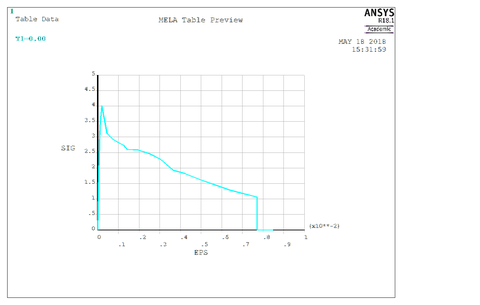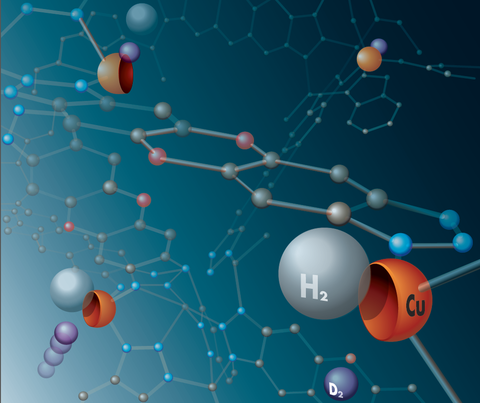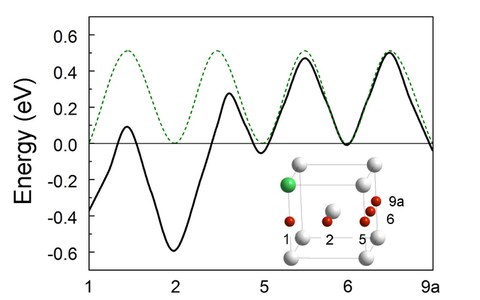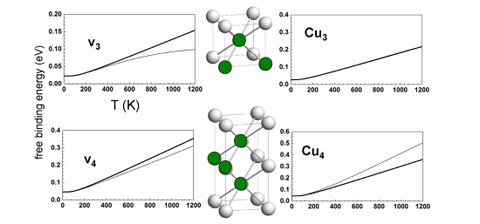Selected HPC User Projects
Table of contents
- Modeling the stiffness degradation of concrete based on physical measurements
- How does insulin activate its receptor ?
- Get to the bottom of quantum properties
- Separation of heavy and super-heavy hydrogen
- First-principles studies on energetics and kinetics of defects and nanoclusters in iron alloys
- Large-scale hunting and gathering of novel viruses
Modeling the stiffness degradation of concrete based on physical measurements
TU Dresden, Faculty of Architecture, Chair of Structural Design, Jürgen Ries
1. 4-point bending test (bar 15x15x70cm)
1.1 Material Model (smeared cracking method)
According to the statistical evaluation of the experimentally determined material parameters (compressive-, bending -, tensile-, splitting tensile strength), the bending strength was identified as the material parameter with the least deviation from the mean value (relative scattering coefficient, coefficient of variation). This leads to the objective of implementing the electronically recorded measurement data of the carried out deformation controlled 4-point-bending-tests (according to test guideline German committee for reinforced concrete DAfStB) into the material model. The experimentally recorded forces and displacements were linearly converted into normalized stresses and strains according to the rules of statics.
The input for the elastic-degrading material model of the steel-fiber-concrete are 20 pairs of values, taken from the measured data of the 4-point bending test.

Input for the elastic-degrading material model of the steel-fiber-concrete
The failure model of the fiber concrete (smeared cracking method) is realised by using a total of 20 experimental value pairs “stress and strain”, reproducing the multilinear-elastic / elastic degrading behaviour. Furthermore the behaviour of the reinforcing steel “Bst500” was simplified implemented as a "smeared" reinforcement with 0.5% (volume per cent) into both directions of the slab plane with bilinear stress-strain behaviour.
The material model of the unreinforced fiber concrete and it’s softening is thus based exclusively on experimentally measured data, taken from the 4-point-bending-tests. The theoretical material models available in "Ansys Mechanical", e.g. “Mohr-Coulomb” or “Drucker-Prager”, have not been applied here. The usual input data of the uniaxial tensile- and compressive strength were also not included into the simulation. When evaluating the 4-point tests, the lowest force-displacement curve is decisive (minimum work performed); this corresponds to a main crack in midspan.
According to the rules of statics, there is a constant bending moment between the load applications, but there is no shear force. The area of damage spreads evenly to the left and to the right of the central main crack. In the area of the damage between the load applications the constant (bending) normal-stress corresponds to the equivalent stress because of the lack of (bending) shear-stress. The (bending) normal-stress together with the plastic strain are the experimental input values of the material model. According to "Kirchhoff's slab theory" the deformation from shear-stress is neglected.
1.2 Recalculation (quasi-static simulation)
Small deviations did occur within the "elastic area” and concerning the flexural strength (peak) because of the simulated “smeared” cracking / damage. Due to the homogeneously distributed stiffness degradation within the simulation, the experimental crack formation can only be approximated. The released crack energy below the curves was mapped very well by the simulation. For a good simulation quality, both element size and deformation speed must be chosen sufficiently small.
2. Modell of the CC struktures (ceiling 4,80x4,80x0,16m)
The FEM model represents a site concrete slab with biaxial load transfer .

Quarter model 2,40x2,40x0,16m, block deformations 20x20cm, deformation controlled

Quarter model, view into the interior of the ceiling with visible CC structures
This project was funded by the “Deutsche Forschungsgemeinschaft DFG” as a part of the SPP1542.
All further results or background information concerning the quasi-static simulation of CC structures can be found here: https://www.researchgate.net/profile/Juergen_Ries, Oktober 2018
+++++++++++++++++++++++++++++++++++++++++++++++++++++++++++++++++++++++++
How does insulin activate its receptor ?
TU Dresden, Group Dr. Coskun, Medizinische Fakultät, Paul Langerhans Institut

Figure 1: Two insulin receptors embedded in a membrane
The hormone insulin regulates metabolism and growth, and its dysregulation is related to severe diseases such as diabetes and cancer. Cells require insulin to efficiently take up sugar. Therefore, insulin acts on cells by binding to its receptor, the so-called insulin receptor, located in the cell membrane. How the insulin receptor is precisely activated by insulin and how this signal is transferred across the membrane is not understood. This is, however, of eminent importance to understand physiological processes and to develop targeted strategies for treating pathologies such as insulin resistance in diabetes.
The receptor’s architecture, its location in the membrane, and the complex binding behavior of insulin impose challenges on structural studies by experimental means. The laboratory of Dr. Ünal Coskun (Paul Langerhans Institute Dresden) succeeded – for the first time – to directly visualize the conformational change in the insulin receptor after insulin binding by electron microscopy http://jcb.rupress.org/content/early/2018/02/15/jcb.201711047. This served as a basis for a collaborative computational approach with resources provided by the ZIH to Dr. Ünal Coskun and by the CSC IT Center for Science (Finland) to Prof. Ilpo Vattulainen (University of Helsinki). Models to simulate the atom-scale molecular dynamics of the full-length or truncated insulin receptor could be built. Those are used for computational simulations, where interactions between atoms and molecules and the resulting movements are calculated numerically. Thus, they provide an atomistic level description of the molecular system and its motion in time. Herein the membrane environment can be defined to match experimental conditions and the interactions with the receptor can be captured. Those models are of enormous size, including one receptor protein, about 2,000 membrane lipids, roughly 500,000 water molecules and 2,800 ions, which altogether contain about 1.7 million atoms. Initial extensive calculations confirmed the robustness and stability of those models. The established experimental approaches done in parallel with the simulations enable to directly test predictions given by the simulations and vice versa.
The main aim is to decipher the molecular mechanism of action of the insulin receptor in its membrane environment and to understand insulin resistance in the context of health and disease.
Further Information: https://tu-dresden.de/med/mf/plid/forschung/Coskun and http://prolipids.helsinki.fi/?page_id=76, March 2018
+++++++++++++++++++++++++++++++++++++++++++++++++++++++++++++++++++++++++
Get to the bottom of quantum properties
TU Dresden, cfaed, Computational Nanoelectronics Group
Researching novel electronic technologies and components has been the task of the Center for Advancing Electronics Dresden. The progressive miniaturization of semiconductor structures is an important trend. Components based on organic electronics have the peculiarity that their function builds on the properties of individual molecules that are often only a nanometer in size and thus obey the laws of quantum theory. Another special feature of organic semiconductors is that the molecules vibrate during current flow and are heavily distorted. This effect is of fundamental importance for charge transport as well as for opto-electronic properties and is known as the polaron effect.
To investigate these complex correlations in detail with the help of HPC simulations has been the task of the working group Dr Frank Ortmann (TU Dresden) made. The exact description of this effect has recently been achieved for a number of molecular structures and has also been experimentally demonstrated with colleagues at the TU Dresden and worldwide partners. In doing so, the researchers investigated the by means of simulation predicted polaron distortion in organic solar cells and were able to determine the predicted quantum properties for the first time exactly. http://pubs.acs.org/doi/abs/10.1021/jacs.6b12857 This effect, which is crucial for the function of solar cells and transistors, can be considered in the future when designing improved materials for organic electronics.
More Information: https://cfaed.tu-dresden.de/ortmann-home, November 2017
+++++++++++++++++++++++++++++++++++++++++++++++++++++++++++++++++++++++++
Separation of heavy and super-heavy hydrogen
Universität Leipzig, AK Prof. Thomas Heine, Lehrstuhl für Theoretische Chemie
The hydrogen isotopes deuterium and tritium are important markers in chemistry, biochemistry and other scientific disciplines, as well as essential components of nuclear fuel for nuclear fusion. At the same time, tritium is an essential component of radioactive waste, especially from heavy water nuclear reactors.
We develop materials for the separation of hydrogen isotopes based on nuclear quantum effects in porous materials (organometallic frameworks and zeolites) and in membranes of two-dimensional crystals (graphene, hexagonal boron nitride, transition metal dichalcogenides, etc.), that offer the production of high purity deuterium, and the trapping of tritium from gas mixtures of hydrogen isotophores.
Unsere Arbeit ermöglicht es, die meisten Experimente ohne den Einsatz von radioaktivem Tritium durchzuführen. Instead, the non-toxic isotopes protium and deuterium are used in experiments. With the data obtained, our theoretical methods are validated, which then allow sound statements about processes and material behavior in relation to tritium.
The resources of the ZIH Dresden thus promote an environmentally friendly research approach in which the use of hazardous procedures or substances is avoided. Instead, theory serves as a link between different experimental disciplines and as a method of predicting potentially dangerous processes.
The best material to date for the separation of tritium-containing hydrogen isotopologues has been developed in cooperation with the Max Planck Institute for Intelligent Systems Stuttgart (AK Hirscher), the University of Augsburg (AK Volkmer) and the Oak Ridge National Laboratory (AK Ramirez-Cuesta). It is an organometallic framework compound with active copper ions that interact strongly with molecular hydrogen. At relatively high temperatures of 100 K, heavy hydrogen isotopologues can be captured from the gas phase and thus the radioactive tritium nuclei are separated. The work has been published in the journal Nature Communications and is open to the public as an open access publication.
Original title in "Nature Communications":
"Capture of heavy hydrogen isotopes in a metal-organic framework with active Cu(I) sites", DOI: 10.1038/ncomms14496
Source: Thomas Heine, Universität Leipzig, November 2017
+++++++++++++++++++++++++++++++++++++++++++++++++++++++++++++++++++++++++
First-principles studies on energetics and kinetics of defects and nanoclusters in iron alloys
Helmholtz-Zentrum Dresden-Rossendorf (HZDR), Bautzner Landstr. 400, 01328 Dresden
The detailed knowledge of the behaviour of lattice defects and foreign atoms in solids is decisive for practical applications of materials. The use of theoretical methods such as first-principle Density Functional Theory (DFT) complements experimental analysis advantageously. In this project two problems of general interest in solid state and materials physics are investigated by DFT: (i) The diffusion of a foreign atom under the influence of other foreign atoms (cf. Fig.1). (ii) The structure and energetics of nanoclusters formed by defects and foreign atoms in a given host crystal (cf. Fig. 2). The present work is focused on body centred cubic Fe as host material which is motivated by the use of dilute iron alloys in numerous fields of application.
Fig. 1 shows the energy barriers an oxygen atom has to overcome during the diffusion in pure iron (green dashed line), and in the environment of a foreign titanium atom (black solid line) [a]. The numbers denote the possible neighbour positions of oxygen (red) relative to titanium (green). Due to the strong binding at the first and second neighbour position the oxygen diffusion slows down remarkably. This was also verified by the calculation of the diffusion coefficient by Kinetic Monte Carlo simulations.
Fig. 2 depicts contributions of phonon excitations or lattice vibrations (thick line) and of the sum of phonon and electron (thin line) excitations to the free binding energy of vacancy and copper clusters vs. temperature. Since positive/negative energy means repulsion/attraction the combined effect of phonon and electron excitations leads to a loss of stability of the clusters with increasing temperature. At 1000 K this loss (related to the ground state binding energy) is about 14 and 18% for v3 and v4, respectively, and for Cu3 and Cu4 it is 36 and 45%, respectively [b,c]. Fig. 2 depicts contributions of phonon excitations or lattice vibrations (thick line) and of the sum of phonon and electron (thin line) excitations to the free binding energy of vacancy and copper clusters vs. temperature. Since positive/negative energy means repulsion/attraction the combined effect of phonon and electron excitations leads to a loss of stability of the clusters with increasing temperature. At 1000 K this loss (related to the ground state binding energy) is about 14 and 18% for v3 and v4, respectively, and for Cu3 and Cu4 it is 36 and 45%, respectively [b,c].
[a] X. Wang et al., unpublished results
[b] D. Murali, M. Posselt, M. Schiwarth: First-principles calculation of defect free energies: General aspects illustrated in the case of bcc Fe, Phys. Rev. B. 92, 064103 (2015)
[c] M. Posselt, D. Murali, M. Schiwarth: Influence of phonon and electron excitations on the free energy of defect clusters in solids: A first-principles study, Comp. Mater. Sci. 127, 284 (2017).
Funded by the Helmholtz Association within the POF III funding scheme (Matter: From Matter to Materials and Life: In-house research on structure, dynamics and function of matter at large scale facilities), as well as by the China Scholarship Council.
The leader of this project (Dr. M. Posselt) is a member of Dresden Center of Computational Materials Science (DCMS) led by TU Dresden. HZDR is a member of the Dresden Concept consortium.
(November 2017)
+++++++++++++++++++++++++++++++++++++++++++++++++++++++++++++++++++++++++
Large-scale hunting and gathering of novel viruses
TU Dresden, Institute for Medical Informatics and Biometry
in Coop. with University of Heidelberg, Department of Molecular Virology
A better understanding of the origin of pathogenic viruses and how they change through time is of vital importance for health care, farming and fundamental research in biology. Gaining insights into these processes of viral evolution is often hindered by a fragmentary and biased knowledge of viruses that exist in nature. In a collaboration between the University of Heidelberg and TU Dresden, researchers discovered dozens of new viruses by screening more than 125,000 sequencing projects of many different animals obtained from a massive database. They took advantage of the fact that the viral genome is sequenced as a by-product if the sample was taken from an infected animal. The costly calculations involving 160 terabyte of data were run on the HPC system Taurus of the ZIH. The newly discovered viruses, together with viruses already known before, span about 400 million years of evolution and bring important insights into the origin of the hepatitis B virus, a major human pathogenic virus that affects an estimated 250 million people world-wide and causes hundreds of thousands of deaths yearly. Since only a tiny fraction of the several petabyte (1015) of available sequencing data has been mined so far, the researchers involved in the project expect to make many more exciting discoveries in the future. Ultimately, they hope to contribute to defining the norm of the human virome and to understand how deviations from that norm affect human health and disease.
For further details: chris.lauber _at_ tu-dresden.de / stefan.seitz _at_ med.uni-heidelberg.de
Literature: Lauber C, Seitz S et al (2017) Cell Host Microbe
(September 2017)
++++++++++++++++++++++++++++++++++++++++++++++++++++++++++++++++++++++++++++
Gaia Calibration and Relativity Tests
TU Dresden, Institut für Planetare Geodäsie, Prof. für Astronomie
The ESA Cornerstone Mission „Gaia“ published on September, 14, 2016 its first data. Experts regarded this event as a revolutionary and eagerly awaited. Gaia is a space mission, whose goal is to determine the 3-dimensional positions and proper motions of approximately one billion stars in outer space. This achieves an accuracy of angular mesuarement of up to ten pico radian. The Lohrman Observatory at the TU Dresden has using a significant amount of CPU time on the HPC system Taurus of the ZIH. This has significantly helped to improve the quality of the astrometric solution.The astrometric solution which provides positions, speeds and distances of the observed objects, is one of the biggest calculations in the history of astronomy. About ten milliards parameters should be determined from billion observations. For the Dresden researchers the cluster nodes with one or two terabytes of RAM were helpful. These made special tests for the study and elimination of systematic errors in the astrometric solution possible and provided a crucial insight. More information: https://tu-dresden.de/bu/umwelt/geo/ipg/astro/raumastrometrie






